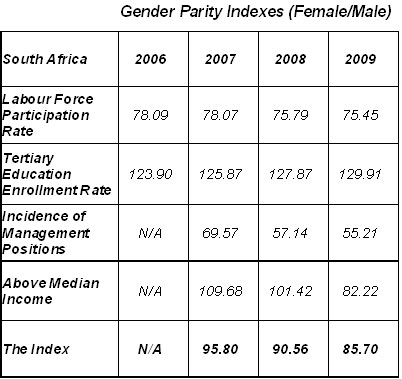
Top stories



The decline, the Index suggests, signifies increasing inequality between men and women as measured according to four key indicators, which are meant to reflect how close or far women in South Africa are to achieving socioeconomic parity with their male counterparts.
The key indicators, which measure the socioeconomic level of women in relation to men, are:
A score below 100 indicates gender inequality in favour of males while a score above 100 indicates inequality in favour of women. A score of 100 indicates equality between the sexes. The Index and its accompanying reports do not represent MasterCard's financial performance.
With the exception of the indicator that measures tertiary enrolment ratios, the indices showed increased inequality at women's expense. The indices relating to “Above median income”; “Incidence of management positions”; and “Labour force participation" reflected scores of 82.2, 55.2 and 75.5 respectively.
In short, not only were fewer women participating in the labour force over the past year compared to men, but, compared to last year, fewer women per 100 men consider themselves to be in management positions.
Moreover, relative to men's perceptions of their earnings, women's impressions of their income levels have also deteriorated, from 50 women per 100 men last year to 45 women per 100 men this year.
The indicator that measures ‘Tertiary education enrolment rates' showed, however, that a higher proportion of women are enrolling for tertiary education than men, with the number of women per 100 men increasing consistently since 2006.
“While the ratio of women to men enrolled in tertiary education in South Africa is growing, a smaller proportion of women feel they are on par with men when it comes to what they earn, their participation in the workforce and their position in the workplace,” said Jill Docherty, Marketing Leader at MasterCard Africa.
“This has impacted women's perceptions of their advancement, especially in South Africa where we see scores declining year-on-year.”
Looking at each indicator in more detail, the indicator measuring above-median income shows that since 2007, women have become increasingly pessimistic about their income levels from a score 109.6 in favour of women in 2007, decreasing marginally to 101.4 in 2008, and now having declined by 19 points to a current pessimistic score of 82.2 in 2009.
“This relative pessimism might be attributable to women feeling financially vulnerable because more men than women consider themselves financial decision-makers according to the survey results, and, compared with men, women allocate more of their income to essential household spending,” said Erika van der Merwe, independent economist.
Following a dramatic decline of more than 12 index points between 2007 and 2008, from 69.6 to 57, the incidence of managerial position component dipped further in 2009, this time by just under two points, to 55.21.
As a percentage, 64.4% of males compared to 35.6% of females say they occupy managerial roles in the workplace. These impressions are borne out by Statistics SA's Labour Force Survey, which shows that, between the first quarter of 2008 and the first quarter of 2009, fewer women were categorised as “employer”, while more men were categorised as “employer”.
The annual census of the Business Women's Association (BWA) confirms that, as a percentage of employees, fewer women hold executive managerial positions in 2009, compared with last year.
MasterCard's estimate of labour force participation rates of women and men in South Africa, based on the World Bank and Unesco datasets, shows that a higher proportion of working-age men are employed than women.
Labour force participation rates deteriorated slightly for women between 2008 and 2009, from 45.5% to 45.0%. As a percentage of the working-age population, men experienced a marginal decline in employment, from 61.4% to 59.6%.
Van der Merwe explained that relative to those for men, lower female participation rates can be explained in part by the fact that working-age women are bearing and raising children, and are therefore not always free to participate in the labour market. The overall effect has been to push women deeper into the territory of inequality. Additionally, the disparity can also be attributed to the limited access to economic opportunity for women.
Considerably more women than men are enrolled at tertiary institutions. This indicator is the only one of the four that indicates inequality in favour of women.
“The overall sentiment, then, is that women are feeling increasingly vulnerable socioeconomically. Thus far, their efforts to counteract this inequality through tertiary-level education have not paid off,” commented van der Merwe.
Looking further afield at the Asia Pacific, Middle East and Africa (APMEA) region where 21 markets were surveyed, it was found that markets in the Middle East and Africa topped this year's Index at 76.9 despite a drop in their overall Index score from 78.3 in 2008. Kuwait emerged with the highest Index score of 112.2, followed by Qatar (104.3), the UAE (93.3) and South Africa (85.7).
Asia/Pacific's overall score of 72.4 is up marginally from its score of 71.6 a year ago, however it still demonstrates inequality in favour of males. Australia had the highest Index score (96.1), followed by Thailand (91.5), New Zealand (90.5) and Singapore (88.3).
“MasterCard has devoted extensive resources to developing a deep understanding of women across the APMEA region. The findings from this MasterCard Worldwide Index of Women's Advancement highlight that there is still much to be done in terms of improving women's self-perceptions,” Docherty concluded.
MasterCard is committed to empowering women through initiatives such as its U21 Global Scholarship for Women in Travel and Tourism, which was launched in 2006 to provide working women professionals a program to develop their leadership skills and realise their full potential in the area of travel and tourism. MasterCard regularly releases consumer insights and trend research on women. These can be accessed at its online repository of proprietary research www.masterintelligence.com.
Additional highlights include:
[1] Qatar was added to the Middle East markets this year.
